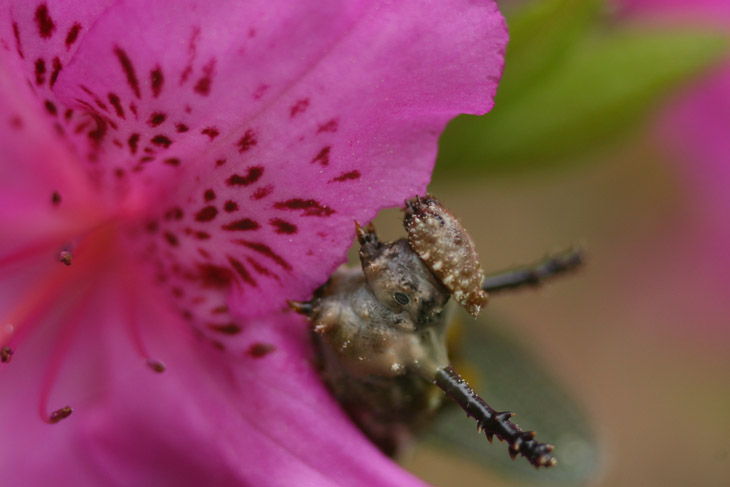
One of the problems with ornamental plants is how much maintenance they might require. The Girlfriend has a new rose bush that she really likes, and last year it got decimated by an early and earnest attack of inchworms – this was in contrast to another rose that came with the property, that remained almost entirely untouched. This year we were ready, and as the season started, we began routine examinations to keep the little buggers at bay. Shown here is not one of the principle inchworm hooligans, but what I believe is a Limenitis instead, the larva of some species of Viceroy or Admiral butterfly. I collected this one to pose on the azalea blossoms, because you gotta love those horns (which were completely harmless, by the way, or at least I was immune.)
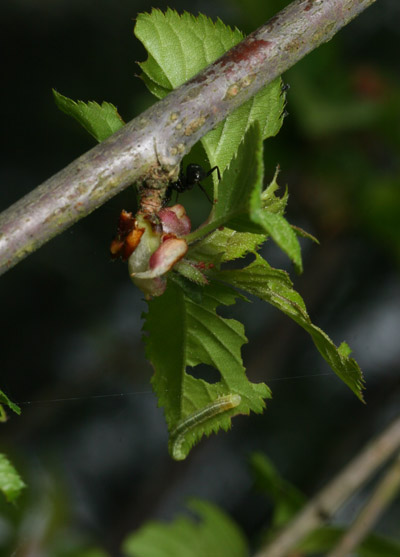 The larva above, one of two such that I found, was assisting the numerous inchworms in raiding the weeping cherry tree, another ornamental that we didn’t want savaged. In that case, however, the ants were helping out an awful lot. The cherry tree came into blossom only a couple of weeks ago, and is now leafing out as well as starting to produce cherries, while the inchworms are partaking of the new leaves. Some of the leaf damage can be seen here alongside the culprit, at center near the bottom of the frame. Directly above it sits a black ant, and the two species demonstrated a paired behavior enough times to know it wasn’t a fluke. As soon as an ant would draw near, before visual contact appeared possible, the caterpillar would bail the leaf to hang beneath on a thin web strand, unable to be captured by the ant. Eventually, once the ant had moved on, the inchworm would draw itself back up to the leaf to resume eating. I never did see an ant actually capture an inchworm, and I’m not even sure that was their main goal, so you might think they were doing little to protect the tree. However, there were a lot of ants, and the ability of the inchworms to eat uninterrupted was seriously hampered by this. While dangling, of course, the inchworms remain vulnerable to any passing bird, or even being carried away by a stiff breeze. They also remain vulnerable to humans with pans of soapy water, which is how a lot of them met their demise.
The larva above, one of two such that I found, was assisting the numerous inchworms in raiding the weeping cherry tree, another ornamental that we didn’t want savaged. In that case, however, the ants were helping out an awful lot. The cherry tree came into blossom only a couple of weeks ago, and is now leafing out as well as starting to produce cherries, while the inchworms are partaking of the new leaves. Some of the leaf damage can be seen here alongside the culprit, at center near the bottom of the frame. Directly above it sits a black ant, and the two species demonstrated a paired behavior enough times to know it wasn’t a fluke. As soon as an ant would draw near, before visual contact appeared possible, the caterpillar would bail the leaf to hang beneath on a thin web strand, unable to be captured by the ant. Eventually, once the ant had moved on, the inchworm would draw itself back up to the leaf to resume eating. I never did see an ant actually capture an inchworm, and I’m not even sure that was their main goal, so you might think they were doing little to protect the tree. However, there were a lot of ants, and the ability of the inchworms to eat uninterrupted was seriously hampered by this. While dangling, of course, the inchworms remain vulnerable to any passing bird, or even being carried away by a stiff breeze. They also remain vulnerable to humans with pans of soapy water, which is how a lot of them met their demise.
 The ant hadn’t even drawn close, but apparently set up some telltale vibrations along the leaf; the ant has moved out of view behind the leaves here. I’ve found that shaking the branches is often enough to trigger the defensive drop, which makes it a lot easier to find and remove the inchworms.
The ant hadn’t even drawn close, but apparently set up some telltale vibrations along the leaf; the ant has moved out of view behind the leaves here. I’ve found that shaking the branches is often enough to trigger the defensive drop, which makes it a lot easier to find and remove the inchworms.
Unlike spiders, inchworms do not produce their web from the hind end, but from their mouths instead; this makes it easier for them to spin their cocoons when the time comes. In many cases, they raise themselves on their hind set of limbs and do a decent impersonation of a twig, which probably works a lot better when they’re perched on a branch itself and not the middle of a leaf, but when they do this, they’re usually attached to the web already, able to drop away in a flash, and I have witnessed numerous specimens sticking up into the air with a gossamer thread anchoring their head to the branch. They also travel while dangling from webbing, carried along by the wind, and on some gusty days I find myself carrying a few hitchhikers, even when I come back into the house.
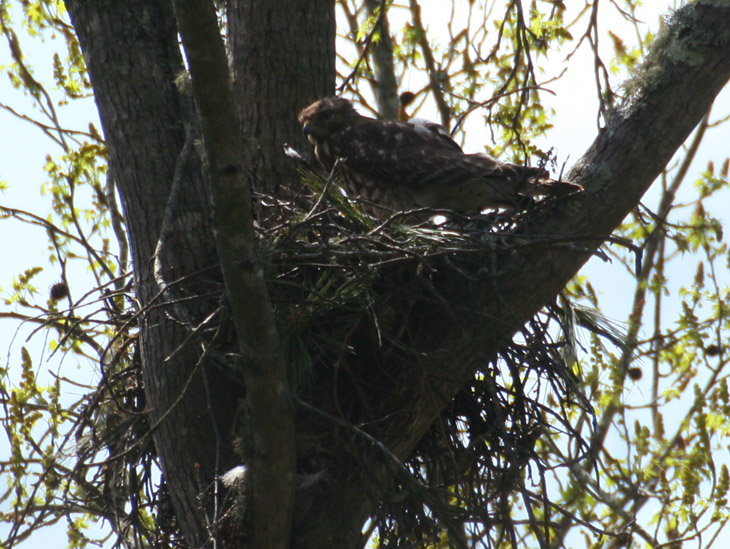 I mentioned earlier about watching a red-shouldered hawk (Buteo lineatus) trying to interest a female in his newly-constructed nest, and he was successful; she is now occupying the nest regularly, and I suspect eggs are soon to arrive if they haven’t already. The distance is a little extreme – this is a tight crop from a frame shot at 500mm – and the light angle is terrible, since my view is due south, so it’s hard to say how much I’ll capture, but I’ll keep watching. You know I’ll keep you updated with any decent pics, and perhaps even some indecent ones.
I mentioned earlier about watching a red-shouldered hawk (Buteo lineatus) trying to interest a female in his newly-constructed nest, and he was successful; she is now occupying the nest regularly, and I suspect eggs are soon to arrive if they haven’t already. The distance is a little extreme – this is a tight crop from a frame shot at 500mm – and the light angle is terrible, since my view is due south, so it’s hard to say how much I’ll capture, but I’ll keep watching. You know I’ll keep you updated with any decent pics, and perhaps even some indecent ones.
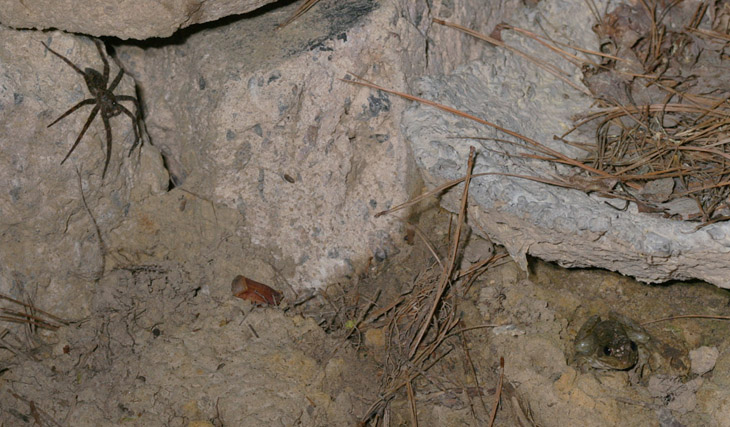
 A pair of green frogs (Lithobates clamitans) wintered over in the bottom of the ornamental pond in the back yard and now make nightly appearances, but what startled me was the fishing spider, which joined them a few nights ago. I could tell you that the frog, at lower right in the image above, is 5cm long and the spider is 2.5cm long in body length (so much more in leg spread,) but it’s more illustrative to show scale. No nature photographers were harmed in the making of this image.
A pair of green frogs (Lithobates clamitans) wintered over in the bottom of the ornamental pond in the back yard and now make nightly appearances, but what startled me was the fishing spider, which joined them a few nights ago. I could tell you that the frog, at lower right in the image above, is 5cm long and the spider is 2.5cm long in body length (so much more in leg spread,) but it’s more illustrative to show scale. No nature photographers were harmed in the making of this image.
This is not the largest fishing spider that I’ve seen, but it’s not far from it either, and fishing spiders are easily the largest genus to be found in the area. I have yet to witness it using the pond for fishing, but it’s still early, especially since few water insects have made an appearance. This is a female, probably full adult, and she may be waiting to mate and form an egg sac, which I’m fairly certain they do suspended in the leaves and branches of nearby plants, such as seen here, though that’s not the same species. This year I have some water plants in pots springing up in the pond, so she should have something to work with in that regard.
By the way, you have to love BugGuide.net. While they have a remarkable community of both amateur and professional entomologists that can help identify arthropods, some of their guidelines are not exactly easy for anyone else to follow:
Additionally Dolomedes tenebrosus features an inverted “v shaped” black mark beginning at the AME extending to the edge of the clypeus enclosing a light spot on the anteromedial margin compared to Dolomedes scriptus which is dark only around each eye with a homogenous medium gray clypeus.
Oh. Okay.
But given all that, I’m inclined to say this is a female Dolomedes tenebrosus, because it’s referring to the ‘face’ of the spider. “AME” is “anterior median eyes,” the front center ‘main’ eyes of a spider, while “clypeus” is a facial plate more or less where the upper lip would be in humans, and in this case “anteromedian margin” means right at the upper edge of this plate. So it refers to the dark marking around the eyes seen here:
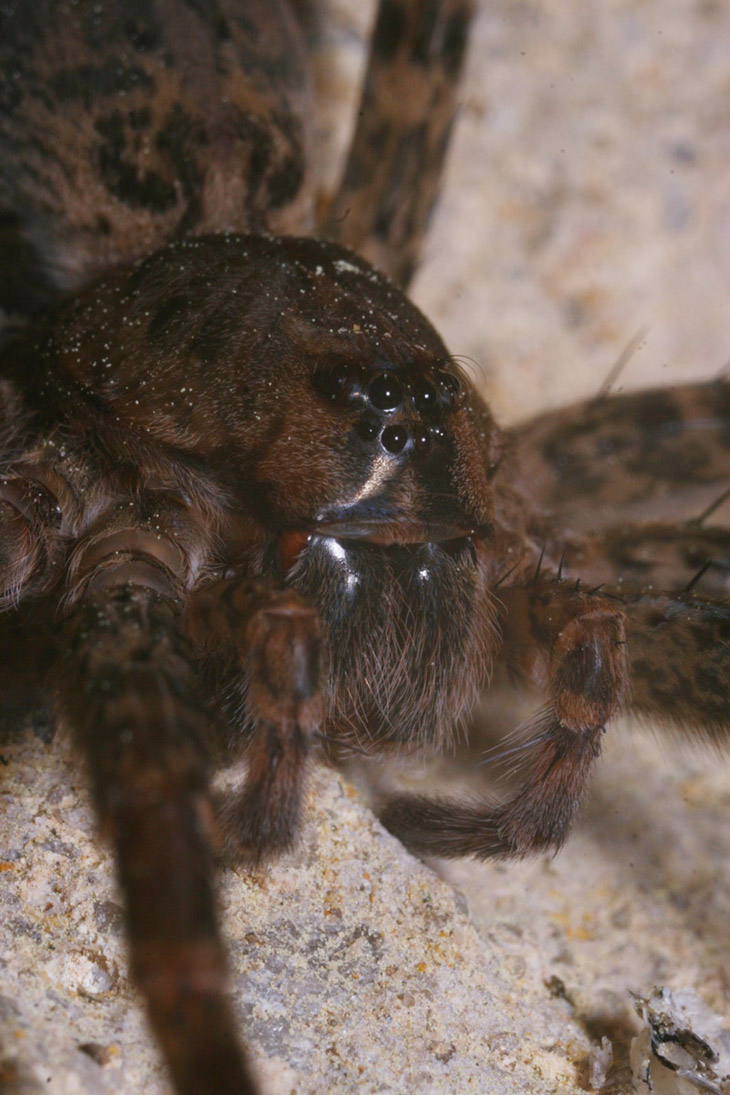
This image, unlike the hawk above, is full-frame; moving carefully while the spider was dazzled by a bright flashlight on a tripod, I was able to get in very close with the 80mm macro and extension tube. A short time back I’d picked up a clamp that had a tripod-socket in it, and this has been invaluable for such pursuits – I highly recommend finding one, like this. It should soon see use in holding the USB microscope too.
By the way, I said I had to move carefully, not because of any aggressiveness on the part of the spider, but because she is shy as any of them, and would take shelter in a crevice whenever she felt threatened, as had happened twice before.
The smaller green frog, seen above, had been trapped in position when I moved between it and the pond, so it had simply hunkered down and played possum, but the larger frog was in a better escape position and hurtled into the water as I approached. Immediately after getting the ridiculous closeups of the spider, though, I found it watching from the surface of the water, and went in for a ridiculous closeup of the frog (but less than half as close as the spider.)
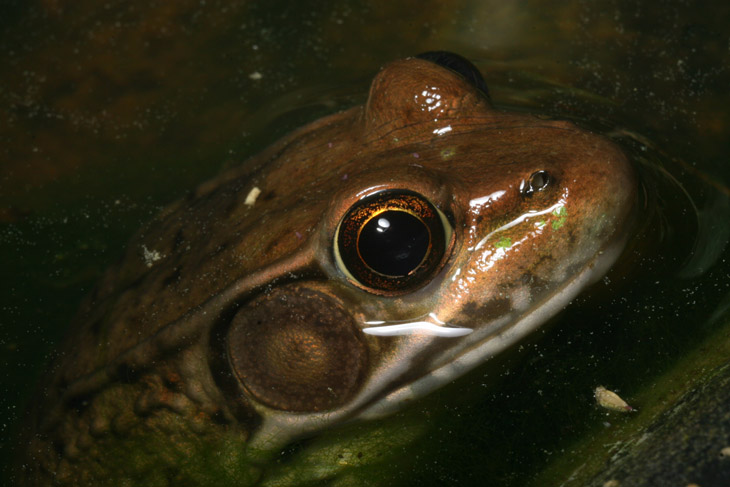
I doubt that I might see anything happen, given that all species involved are nocturnal yet change their behavior when observed by the bright lights I need to observe then, but the fishing spider might well be a prime food source for the frogs – it will be interesting to see if she remains. I expect to see frog eggs soon too.
In fact, from more than one species. The Copes grey treefrog shown twice earlier has been hanging around on the deck, less than a dozen meters from the pond, so if that’s a female, she may be depositing her eggs there as well. I’ll close with one more photo of that one, when she (?) presented a mellow pose on the edge of a potted plant.

I should probably just let this sit as it is, but I can’t resist giving my own impression, which is that she is waiting patiently for you to admit to that obvious lie you just told. Perhaps this says far too much about me…




















































